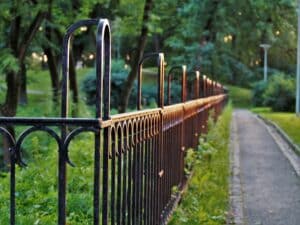Today, we’re diving into the world of ranch rail fences. You know, those sturdy fences you often see lining up farms and large properties. They’re simple in design, usually featuring a few horizontal rails attached to posts, but don’t let that simplicity fool you. These fences are as much about function as they are about looks.
Ranch rail fences aren’t just there to mark your property line or keep your livestock from wandering off. They’ve got a certain charm to them, blending in with almost any landscape. Whether you’ve got a small plot or acres of land, these fences add a touch of rustic elegance.
In this post, we’ll cover everything from their humble beginnings in the fields to the various styles you see today. We’ll also touch on why these fences have become a staple in different parts of the world. Stick around, and you’ll get a good sense of why these fences have stood the test of time.
History and Origin of Ranch Rail Fences
Let’s start at the beginning. Ranch rail fences have been around for ages, and they started off as a practical solution in agricultural settings. Back in the day, farmers needed something straightforward and sturdy to keep their animals in and unwelcome visitors out. That’s where the idea for these fences came from – simplicity and functionality were key.
Over the years, the design of ranch rail fences has evolved. Initially, they were made from whatever materials were on hand – often wood from the nearby forests. But as time went on, folks started getting more creative. They began experimenting with different materials and designs, adapting the fences to suit different climates and needs.
But it’s not just about keeping cows from straying. Ranch rail fences have a cultural significance too. From the sprawling ranches of the American West to the rolling hills of European countryside, these fences are a part of the landscape. They tell a story of the land and the people who work it. In some places, the style of the fence can even give you a hint about the history and traditions of the area.
So, that’s a brief trip through the history of ranch rail fences. They might seem like a simple part of the landscape, but there’s a rich story behind them. Stay tuned as we dig deeper into the characteristics and benefits of these iconic fences.
Characteristics of Ranch Rail Fences
Alright, let’s talk about what makes a ranch rail fence what it is. The typical design is pretty straightforward – you’ve got your vertical posts dug into the ground, sturdy as can be, and then there are the horizontal rails. These rails are usually spaced out evenly, giving the fence its signature look. It’s a design that’s easy to put up and easy on the eyes.
Now, about the materials. Back in the old days, it was mostly wood – oak, cedar, pine, you name it. Wood’s got a natural look that’s hard to beat, and with the right care, it can last a good long while. But these days, you’ve got more options. Vinyl’s become popular for folks who want less upkeep. It doesn’t rot or need repainting, and it holds up well against the weather. Then there’s metal – typically steel or aluminum. It’s strong, durable, and gives a more modern feel.
The style of ranch rail fences can vary a lot. Some have two rails, others might have three or four, depending on the need. The height can vary too. A fence meant to keep in large animals like horses will be taller than one for smaller critters or just for marking property lines. It’s all about what you need the fence for, and of course, a bit of personal taste.
Functional Benefits of Ranch Rail Fences
Now, the practical side of things. Ranch rail fences aren’t just for show. They’ve got a bunch of practical uses. The most obvious is livestock containment. These fences are great for keeping horses, cows, and other animals where they should be. They provide a clear boundary for the animals, helping prevent them from straying onto roads or neighboring properties.
Speaking of boundaries, that’s another key use – property demarcation. A good fence makes it clear where your land starts and ends. It’s a straightforward way to avoid disputes with neighbors and keep trespassers at bay.
Then there’s the matter of wind protection and privacy. A solidly built ranch rail fence can break the wind, providing a bit of shelter for your property and animals. And while they’re not as private as a solid wall, these fences do give a sense of seclusion without making your property look like a fortress.
Lastly, let’s talk about maintenance and durability. Like anything, a ranch rail fence will last longer with the right care. Wood fences need to be checked for rot and pests, and might need a coat of paint or sealer now and then. Vinyl and metal require less upkeep, but it’s still good to keep an eye on them for any damage or wear. No matter the material, a well-maintained fence can serve you well for many years.
Aesthetic Appeal
Now, let’s chat about the look of these fences. Ranch rail fences aren’t just functional; they’ve got a style that can really shape the feel of a place. In landscape design, these fences are like the backbone of your property’s look. They frame your land, add a sense of order, and bring that classic, rustic charm that never goes out of style.
Customization is where you can really make your fence stand out. The type of wood and the finish can change the whole vibe of your fence. A dark stain on pine or a natural cedar look? That’s your call. With vinyl and metal, you’ve got a bunch of colors to choose from. And then there’s the layout – straight lines are just the start. You can have curves, add decorative posts, or even mix materials for a unique look.
Let’s talk real examples. You’ve got the classic horse farm with its white, four-rail wooden fence – that’s a picture right out of a magazine. Then there’s the modern ranch house with a sleek, black metal fence – minimal and stylish. Every setting calls for something different, and these fences can adapt to fit the bill.
Installation Considerations
Alright, putting up one of these fences isn’t rocket science, but there’s a bit to think about. First off, you gotta plan your layout. Mark where your posts will go and make sure you’re within your property lines. Digging the post holes is next – they need to be deep enough to hold the posts steady and to withstand frost if you’re in a colder area.
Now, DIY or hire a pro? If you’re handy and have the time, DIY can save you some cash. But it’s a big job, and a pro will have the right tools and know-how to get it done quick and right. Plus, they can handle any tricky bits like uneven ground or special layouts.
Before you start, there are a couple of important things to check. Local regulations, for one. Some places have rules about fence height or style, especially in urban areas. And don’t forget about utilities – you don’t want to be digging into any underground lines. Lastly, think about the terrain and soil type. Rocky ground, slopes, and wet areas can all make the job a bit trickier.
Getting a fence up isn’t just about putting some posts in the ground. It’s about planning and knowing what you’re working with. Do it right, and you’ll have a fence that looks great and lasts for years.
Maintenance and Care
Keeping your ranch rail fence in tip-top shape is key to ensuring it lasts. For wooden fences, regular checks for rot or pest damage are essential. A coat of paint or sealant every few years will keep the wood protected from the elements. If you spot a damaged or rotting post, replace it pronto to prevent further issues.
Vinyl fences are a bit easier to care for. A good wash with soap and water now and then keeps them looking fresh. Check for any cracks or damage, especially after extreme weather.
Metal fences, on the other hand, might need a check for rust spots, which can be sanded and repainted. Also, ensure that the connections and bolts are tight and secure.
Common issues with ranch rail fences include leaning posts, loose rails, and weather damage. Regular maintenance checks can catch these problems early, saving you bigger headaches down the road.
As for longevity, a well-maintained wood fence can last 20 years or more, while vinyl and metal can go even longer. When it comes to replacement, consider the condition of the entire fence. Sometimes, replacing a few parts is enough, but other times, you might need a whole new fence.
Conclusion
Ranch rail fences are more than just barriers; they’re a key part of your property’s character. They blend functionality with aesthetics, offering versatility that suits various landscapes and needs. Whether you’re keeping livestock safe, marking property boundaries, or just adding a touch of rustic charm, these fences have got you covered.
If you’re considering a ranch rail fence, think about what we’ve covered here. They can be a great addition to your property, and with the right care, they’ll serve you well for years.
I’d love to hear your thoughts and experiences with ranch rail fences. Drop a comment below and let’s keep the conversation going.
Additional Resources
- American Fence Association
- National Wooden Fence Manufacturers Association
- Vinyl Fence Manufacturers Association
For expert advice or supplies, reach out to local fencing companies or hardware stores. They’ll have the know-how and materials to get you started.
Got a story or a picture of your ranch rail fence? Share it with us! And if you’re looking to install or upgrade a fence, don’t hesitate to reach out to professionals for advice and help. And hey, if you found this guide useful, share it with your friends and neighbors. Let’s spread the word about the good old ranch rail fence!



